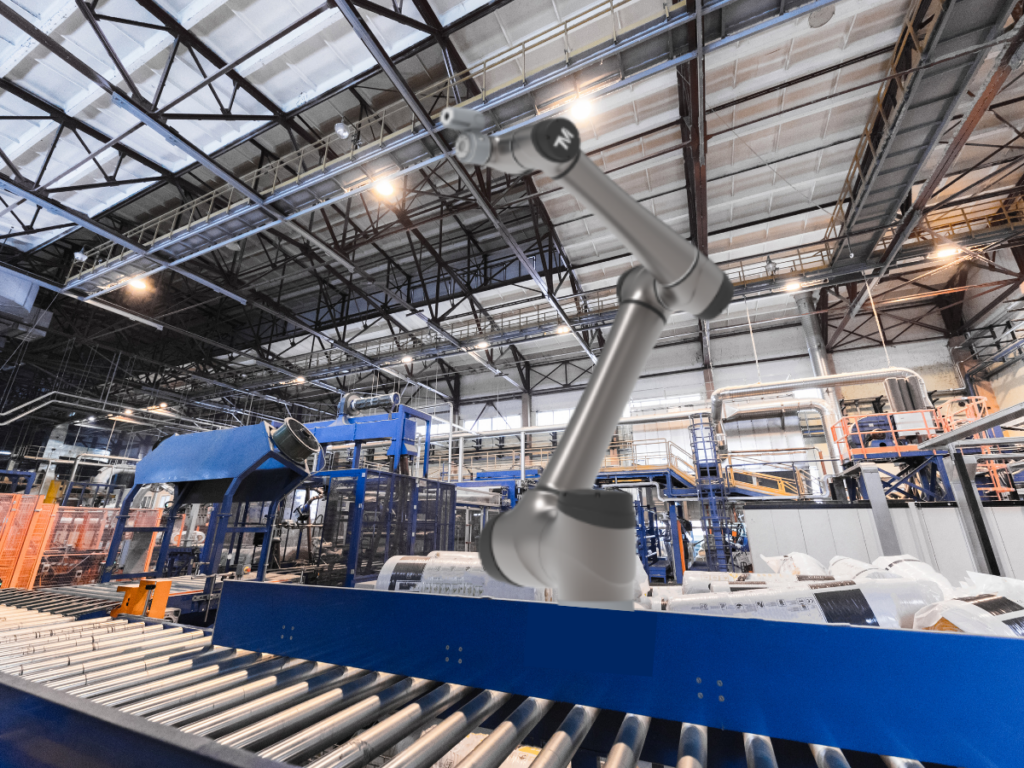TM30S: Breaking Barriers in Collaborative Robots
As the use of cobots in manufacturing continues to grow, advances in robotics are giving rise to new technologies, such as Techman Robot’s TM30S, an new collaborative robot that excels in high-volume industrial tasks. This blog will explore the advantages of using robotics in manufacturing and discuss the features of the TM30S so you can decide if it’s right for your industrial application.
How has Robotics Changed Manufacturing?
Since the introduction of robotics in manufacturing, users have discovered that applying industrial robots to automate tasks provides significant benefits, such as improving safety, efficiency and product quality.
Below are several advantages of using robotics in manufacturing:
- Increased speed and efficiency: Industrial robots are built for speed and accuracy so they can complete tasks with more efficiency and at faster rates than manual laborers. Further, because they can work continuously without breaks and without fatigue, the output of a production line will increase significantly. As a matter of fact, some statistics show that there is a 40% increase in productivity when replacing just one employee with an industrial robot.
- Improved plant safety: Safety is also boosted as industrial robots can work in high-risk areas and perform hazardous activities, eliminating the need to send workers into dangerous situations by allowing robots to perform physically demanding or risky activities in danger zones. Additionally, because robots excel at performing repetitive tasks that include heavy lifting, bending and twisting, they can be applied to activities that typically result in repetitive motion injuries in human employees, further reducing on-the-job injuries and improving the plant’s safety record, while also reducing workers’ compensation and insurance costs.
- Enhanced product quality: Product quality tends to improve with the use of robotics in manufacturing facilities, as well, because robots provide higher levels of precision and perform the same tasks with more consistency and accuracy than manual laborers. This ensures that products are always manufactured to exacting specifications. As a bonus, improving product quality via the use of robots often reduces costs associated with scrap and waste because there are fewer defects and faulty products when robots perform assembly or other tasks. Robots can also be used for inspection purposes and are more likely to detect flaws than humans because machine vision is more accurate than human vision, which prevents damaged products from reaching consumers.
The Rise of Cobots in Manufacturing

Collaborative robots, or cobots, are a modern generation of industrial robots that are growing in popularity. In addition to being more cost effective and less complex than traditional industrial robots, collaborative robot safety standards permit cobots to work in close proximity to human workers. Cobots are engineered with advanced navigation technologies, safety sensors and software algorithms that allow them to automatically stop moving upon collision with obstacles (or humans) and exert minimal force if a collision does occur.
Due to the capabilities provided by collaborative robot safety standards, cobots can safely operate in work spaces that are shared with humans. In addition, cobots are easier to program and provide more flexibility than traditional industrial robots so they can be adapted to different tasks around a facility.
Because of the lower costs, enhanced flexibility and ease of programming, there has been an increased demand for cobots in manufacturing settings. For this reason, providers of collaborative robots, such as Techman Robot, have continued to develop innovative collaborative robot technologies.
Advances in Robotics: Techman Robot’s TM30
As a matter of fact, Techman Robot is breaking barriers in collaborative robot technology with the introduction of the TM30S robotic arm. Designed to be robust and suitable for heavy industrial work, including palletizing and packaging, pick-and-place, material handling and heavy machine tending, the high-payload, AI-enhanced, collaborative robot offers a 35 kg payload while maintaining a long reach with the use of six joints.
The six-axis cobot enables a 25% faster cycle time than previous models. Repeatability is also enhanced, so the TM30S offers a 70% accuracy rating within a range of 0.03 mm.
Operation is also simplified with Techman Robot’s new Robot Stick that features a three-position enabling switch and reset button for safer – and easier – operation. The Robot Stick can be used with a monitor, keyboard and mouse and combined with a TM screen accessory that uses visualization to make it easier for operators to teach, debug and control the cobot.
The TM30S offers innovative AI technology, including an AI-capable camera attached to the arm, allowing AI pattern recognition and machine learning so that the cobot may automatically learn decision rules, which results in more accurate visual data analysis and, ultimately, higher levels of efficiency. The addition of advanced AI ensures that the TM30S can successfully manage a variety of vision tasks, such as classification, object detection, segmentation and anomaly detection.
In addition to heavy-duty, yet simple operation, the TM30S meets several collaborative robot safety standards and offers up to 31 safety functions certified by TṺV. These safety functions comply with the latest version of ISO 10218-1 and are certified as PL d, Cat. 3, according to ISO 13849-1. The cobot is also SGS-certified for UL and CSA and North America and complies with CE requirements for Europe as partly completed machinery. It meets key safety standards, including the Machinery Directive, ISO 10218-1 and ISO 13849-1 and comes with a Declaration of Incorporation.
To learn more about Techman Robot’s TM30S and how its advanced safety features, heavy-duty handling and maneuverability can increase the safety, efficiency, product quality and reliability of your operation, please contact JHFOSTER, a Tavoron company today.
